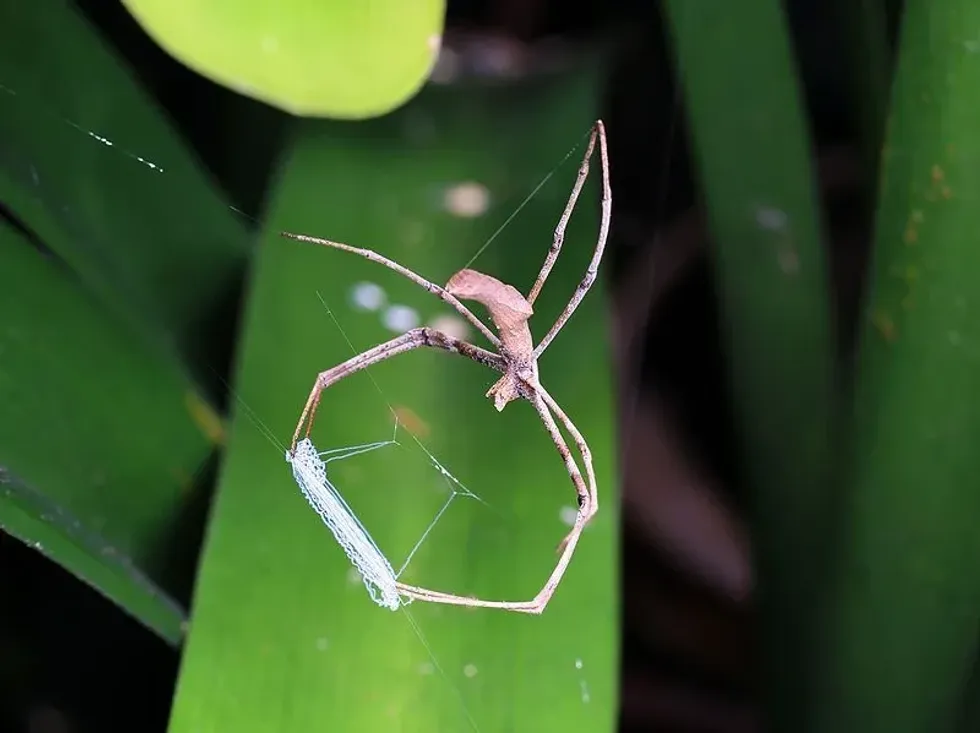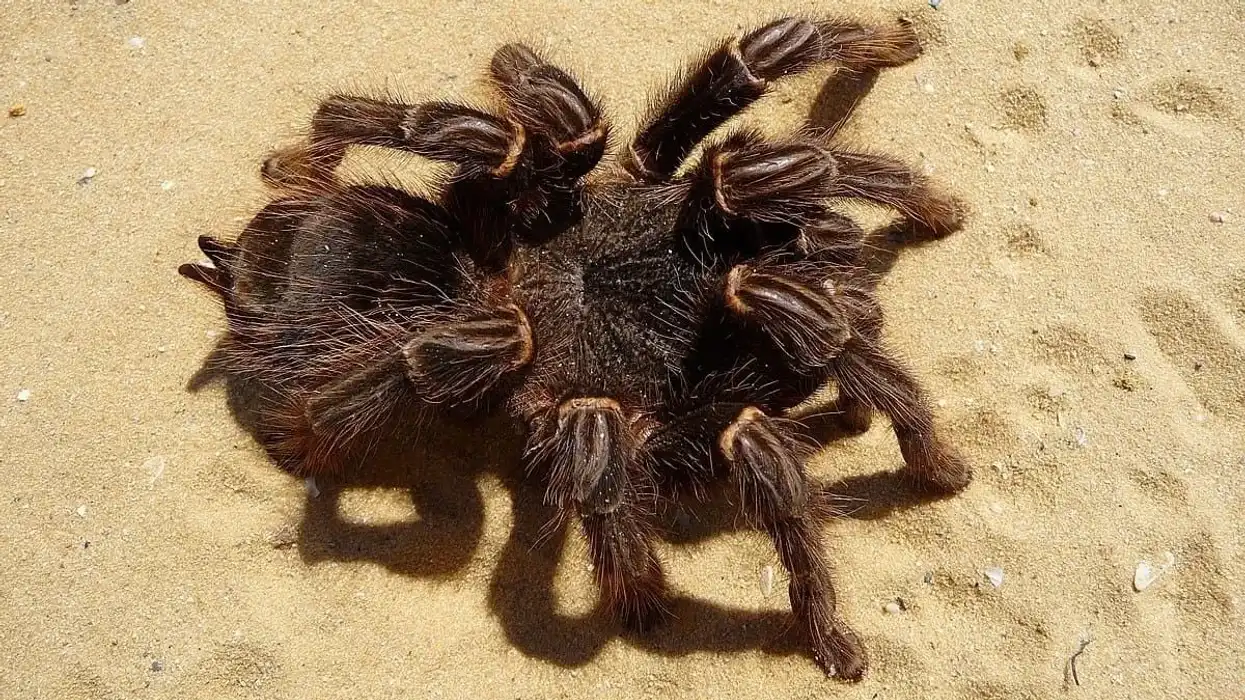Have you ever heard of the net-casting spider? This unique insect is also known as Deinopidae and was first written about by Carl Ludwig Koch, a German entomologist, in 1850.
Net-casting spiders are native to Australia, Africa, and the USA. There are two genus types based on the structure of their body, Deinopis (Ogre-faced Spiders) and Menneus (humped back Spiders). Avella and Avellopsis are the earlier genera that are grouped under Menneus lately.
These spiders have a quirky way to capture their prey by forming a tiny cribellate silk web through their front legs. They can expand their web by two or three times to capture the insect passing by.
Net-casting spiders possess a long, twig-like body, stretched legs, and eight eyes, two of which are massive and situated at the front portion of the head (Ogre-faced). These big eyes enable the spider to be active during the night effectively. Male net-casting spiders are smaller than females. The net-casting spider species are abundantly available.
If you like net-casting spider facts, you can also check and develop knowledge about Darking Beetle Facts and Puss Moth Facts here.
Net Casting Spider Interesting Facts
What type of animal is a Net Casting Spider?
Net-casting spiders are arboreal insects and a part of the cribellate family. They are active at night for hunting, where they create a silky web first and select a suitable place where their prey can likely cross by.
They differ in color from light brown to chocolate brown. The genus of these spiders will vary based on the size of their eyes, color, and the pattern present on their body.
What class of animal does a Net Casting Spider belong to?
Net-casting spider belongs to the Arachnida class of the Animalia Kingdom and Arthropoda Phylum.
How many Net Casting Spiders are there in the world?
The exact count of net-casting spiders is unknown. However, there are two genera and 68 species of net-casting spiders globally. Deinopis (Ogre-faced spiders) and Menneus (Group of Avella and Avellopsis) are the two types of genus. Deinopis subrufa, Deinopis longipes, Menneus nemesio, and Menneus camelus are a few known species.
Where does a Net Casting Spider live?
Net-casting spider (Deinopidae), as a typical insect, lives in gardens, flat areas outside of the house, and medium to high torrid zones. Rufous net casting spider (Deinopis subrufa) is spread across Australia, Eastern and Southern Africa, and America.
What is a Net Casting Spider's habitat?
Net-casting spiders (Deinopidae) preferred habitat is bushes, gardens, plants, and trees.
Who does Net Casting Spider live with?
There has not been any specific study to understand whether these spiders live in solitary or in a group.
How long does a Net Casting Spider live?
A net-casting spider lives for about a year.
How do they reproduce?
Pairing and producing eggs will happen during the late summer in general. Males Spiders usually feed females before mating. They will slough their skin and will look for a matching pair.
They will exhibit their interest by lying on the outer part of the female's web. After mating happens, males will die. Females build an egg sac that can hold 100-200 eggs.
The gestation period would be around three weeks, after which hatching will happen. The egg sac, which a leaf would conceal, would be 10-12 mm in diameter and pale brown with thick brown dots. Young ones will eat the egg sac for nutrients.
What is their conservation status?
They are abundantly available and Not extinct.
Net Casting Spider Fun Facts
What does Net Casting Spider look like?

Net-casting spiders will have a thinner body and have eight eyes out of which two will be present on the front part of the head. Those two eyes would be mammoth which helps for catching prey at night. Females are bigger than males in size.
What is the largest Net Casting Spider?
Ogre-faced spiders might be the largest net casting spider with their large eyes and distant hearing capacity. They are also the famously known spiders in this genus.
How do they communicate?
They communicate via acoustic signals.
How big is a Net Casting Spider?
Net-casting spiders will be one inch in size in normal conditions that can expand to three inches when they spread their legs.
How fast can Net Casting Spider move?
It is expected that the net-casting spider can move at a similar speed to that of a common spider, though there has not been any evidence for this.
How much does a Net Casting Spider weigh?
The net-casting spider should weigh the same as a common spider.
What are the male and female names of the species?
There are no specific names for male and female net-casting spiders, and they are commonly called net-casting spiders.
What would you call a baby Net Casting Spider?
A baby net-casting spider is called a spiderling.
What do they eat?
They eat crickets like cockroaches, and grasshoppers, beetles, ants, and in rare scenarios, they eat other spiders.
Are they harmful?
Net-casting spiders are not dangerous, as they do not cause any harm to humans.
What is the largest species of Net Casting Spider?
Spider of the Deinopis genus type (ogre-faced spiders) is one of the largest known species of the spider genus. However, there have not been any comparison studies about the different species of the net-casting spider yet.
Did you know...
Net-casting spiders have more powerful eye vision than cats and owls at night. Also, it is surprising to know that the eyes of male net-casting spiders dwindle as they mature.
How do their webs work?
Net-casting spiders sway from the plants with their heads pointing downwards to look for prey. They will form silky nets held by their front legs and supported by their back legs.
This net-like cribellate silk web will be a mix-up of white and blue. Though the silk web is not sticky, the silk web grids are designed to smoothly expand and entwine the insects.
They emit white facial droplets onto the foliage. When the insects come nearer to the silk web, they will jump strong onto it, entangle them, making sure they cannot move and shake further and eat them comfortably.
The silk web that has not been used for seizing prey overnight is either left as is to catch the prey the next night or might be eaten by the net casting spider themselves. The approximate time to build their silk web would be half an hour.
How do Net Casting Spiders use their venom?
Ogre-faced net-casting spiders have tender venom that is not poisonous to humans. Instead, the venom is used for catching insects.
Here at Kidadl, we have carefully created lots of interesting family-friendly animal facts for everyone to discover! Learn more about some other arthropods including these cicada killer wasp facts and click beetle facts.
You can even occupy yourself at home by drawing one of our net-casting spider coloring pages.










